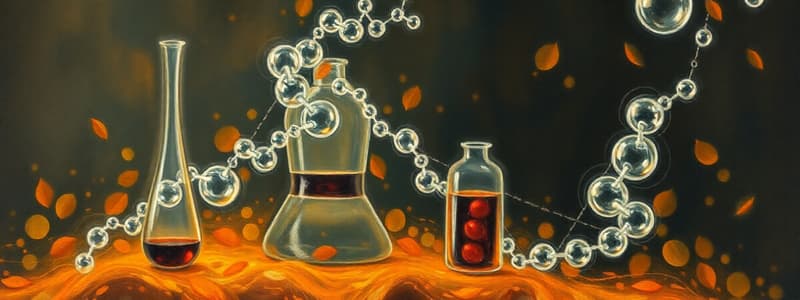Podcast
Questions and Answers
What is the primary source of energy obtained from carbohydrates?
What is the primary source of energy obtained from carbohydrates?
- Fructose
- Glucose (correct)
- Pyruvate
- Glycogen
Which of the following is NOT a direct product of the breakdown of complex carbohydrates in the diet?
Which of the following is NOT a direct product of the breakdown of complex carbohydrates in the diet?
- Disaccharides
- Glucose
- Amino acids (correct)
- Monosaccharides
Where does glycolysis primarily take place within a cell?
Where does glycolysis primarily take place within a cell?
- Nucleus
- Golgi apparatus
- Cytosol (correct)
- Mitochondria
What is the name given to the process that converts glucose into pyruvate?
What is the name given to the process that converts glucose into pyruvate?
What is the key characteristic of glycolysis?
What is the key characteristic of glycolysis?
What is the net gain of ATP molecules produced during glycolysis?
What is the net gain of ATP molecules produced during glycolysis?
Which of the following is not a product of glycolysis?
Which of the following is not a product of glycolysis?
In the first phase of glycolysis, glucose is converted into what?
In the first phase of glycolysis, glucose is converted into what?
Which of the following correctly describes the role of NAD+ in glycolysis?
Which of the following correctly describes the role of NAD+ in glycolysis?
What is the fate of the pyruvate produced at the end of glycolysis?
What is the fate of the pyruvate produced at the end of glycolysis?
What is the final electron acceptor in the electron transport chain?
What is the final electron acceptor in the electron transport chain?
Which of the following is NOT a component of the electron transport chain?
Which of the following is NOT a component of the electron transport chain?
Where are the enzymes responsible for the citric acid cycle located within the mitochondria?
Where are the enzymes responsible for the citric acid cycle located within the mitochondria?
What is the primary function of Coenzyme Q (UQ/CoQ) in the electron transport chain?
What is the primary function of Coenzyme Q (UQ/CoQ) in the electron transport chain?
During electron transport, what happens to the oxidation-reduction potential of the electron carriers?
During electron transport, what happens to the oxidation-reduction potential of the electron carriers?
Where is cytochrome c located within the mitochondria?
Where is cytochrome c located within the mitochondria?
Which molecule is directly responsible for the production of ATP in oxidative phosphorylation?
Which molecule is directly responsible for the production of ATP in oxidative phosphorylation?
What is the primary function of the electron transport chain in cellular respiration?
What is the primary function of the electron transport chain in cellular respiration?
What is the function of Pyruvate dehydrogenase (PDH)?
What is the function of Pyruvate dehydrogenase (PDH)?
Which of the following statements accurately describes the location of the Pyruvate dehydrogenase complex (PDC) in eukaryotic cells?
Which of the following statements accurately describes the location of the Pyruvate dehydrogenase complex (PDC) in eukaryotic cells?
What is the role of Pyruvate dehydrogenase kinase and Pyruvate dehydrogenase phosphatase in the Pyruvate dehydrogenase complex (PDC)?
What is the role of Pyruvate dehydrogenase kinase and Pyruvate dehydrogenase phosphatase in the Pyruvate dehydrogenase complex (PDC)?
What is the main function of the Citric Acid Cycle (CAC)?
What is the main function of the Citric Acid Cycle (CAC)?
What is the role of NADH and FADH2 in the Citric Acid Cycle (CAC)?
What is the role of NADH and FADH2 in the Citric Acid Cycle (CAC)?
Which of the following reactions is catalyzed by isocitrate dehydrogenase in the Citric Acid Cycle (CAC)?
Which of the following reactions is catalyzed by isocitrate dehydrogenase in the Citric Acid Cycle (CAC)?
Which enzyme in the Citric Acid Cycle (CAC) is responsible for the formation of citrate?
Which enzyme in the Citric Acid Cycle (CAC) is responsible for the formation of citrate?
What is the role of succinate thiokinase in the Citric Acid Cycle (CAC)?
What is the role of succinate thiokinase in the Citric Acid Cycle (CAC)?
Which complex in the electron transport chain (ETC) directly uses succinate as a substrate?
Which complex in the electron transport chain (ETC) directly uses succinate as a substrate?
Which complex in the ETC is responsible for the reduction of oxygen to water?
Which complex in the ETC is responsible for the reduction of oxygen to water?
Which of the following is NOT a prosthetic group found in Complex III (Ubiquinol-cytochrome c reductase)?
Which of the following is NOT a prosthetic group found in Complex III (Ubiquinol-cytochrome c reductase)?
What is the role of ubiquinone (UQ) in the ETC?
What is the role of ubiquinone (UQ) in the ETC?
What is the direct product of the reaction catalyzed by Complex I (NADH dehydrogenase)?
What is the direct product of the reaction catalyzed by Complex I (NADH dehydrogenase)?
In which direction are protons moved across the inner mitochondrial membrane during the ETC?
In which direction are protons moved across the inner mitochondrial membrane during the ETC?
Which of the following is the final electron acceptor in the ETC?
Which of the following is the final electron acceptor in the ETC?
Which of the following statements accurately describes the relationship between the ETC and ATP synthesis?
Which of the following statements accurately describes the relationship between the ETC and ATP synthesis?
Which of the following is NOT a product of pyruvate dehydrogenase complex (PDC) activity?
Which of the following is NOT a product of pyruvate dehydrogenase complex (PDC) activity?
What is the primary fate of pyruvate under anaerobic conditions in muscle cells?
What is the primary fate of pyruvate under anaerobic conditions in muscle cells?
Which of the following is a correct statement about triphosphate/diphosphate?
Which of the following is a correct statement about triphosphate/diphosphate?
What is the primary function of the citric acid cycle?
What is the primary function of the citric acid cycle?
Which of the following is a reduced electron carrier generated during the citric acid cycle?
Which of the following is a reduced electron carrier generated during the citric acid cycle?
Which of the following statements about alcoholic fermentation is TRUE?
Which of the following statements about alcoholic fermentation is TRUE?
What is the role of NAD+ in the conversion of pyruvate to lactate?
What is the role of NAD+ in the conversion of pyruvate to lactate?
Which of the following molecules is a key intermediate in both glycolysis and gluconeogenesis?
Which of the following molecules is a key intermediate in both glycolysis and gluconeogenesis?
Which of the following describes the role of the pyruvate dehydrogenase complex (PDC) in the citric acid cycle?
Which of the following describes the role of the pyruvate dehydrogenase complex (PDC) in the citric acid cycle?
Why is the citric acid cycle considered a central pathway in metabolism?
Why is the citric acid cycle considered a central pathway in metabolism?
Flashcards
Carbohydrate metabolism
Carbohydrate metabolism
The process by which carbohydrates are broken down for energy.
Glycolysis
Glycolysis
The metabolic pathway that converts glucose into pyruvate, releasing energy.
Monosaccharides
Monosaccharides
Simple sugars, like glucose, that are the end products of carbohydrate digestion.
Citric acid cycle
Citric acid cycle
Signup and view all the flashcards
Pyruvate
Pyruvate
Signup and view all the flashcards
Equation of Glycolysis
Equation of Glycolysis
Signup and view all the flashcards
Oxidation in Glycolysis
Oxidation in Glycolysis
Signup and view all the flashcards
Phases of Glycolysis
Phases of Glycolysis
Signup and view all the flashcards
Structure of Glucose vs. Pyruvate
Structure of Glucose vs. Pyruvate
Signup and view all the flashcards
Triphosphate/Diphosphate
Triphosphate/Diphosphate
Signup and view all the flashcards
Trisphosphate/Bisphosphate
Trisphosphate/Bisphosphate
Signup and view all the flashcards
Fructose 1,6-bisphosphate
Fructose 1,6-bisphosphate
Signup and view all the flashcards
Pyruvate to Acetyl-CoA
Pyruvate to Acetyl-CoA
Signup and view all the flashcards
Pyruvate Dehydrogenase
Pyruvate Dehydrogenase
Signup and view all the flashcards
Aerobic vs Anaerobic Pathways
Aerobic vs Anaerobic Pathways
Signup and view all the flashcards
Lactic Acid Fermentation
Lactic Acid Fermentation
Signup and view all the flashcards
Alcoholic Fermentation
Alcoholic Fermentation
Signup and view all the flashcards
Citric Acid Cycle Role
Citric Acid Cycle Role
Signup and view all the flashcards
Pyruvate Dehydrogenase Complex (PDC)
Pyruvate Dehydrogenase Complex (PDC)
Signup and view all the flashcards
Electron Transport Chain (ETC)
Electron Transport Chain (ETC)
Signup and view all the flashcards
Reduced Coenzymes
Reduced Coenzymes
Signup and view all the flashcards
Oxidation-Reduction Potential
Oxidation-Reduction Potential
Signup and view all the flashcards
ATP Synthesis
ATP Synthesis
Signup and view all the flashcards
Inner Mitochondrial Membrane
Inner Mitochondrial Membrane
Signup and view all the flashcards
Flavoproteins
Flavoproteins
Signup and view all the flashcards
Coenzyme Q (UQ/CoQ)
Coenzyme Q (UQ/CoQ)
Signup and view all the flashcards
Cytochrome c
Cytochrome c
Signup and view all the flashcards
Complex I
Complex I
Signup and view all the flashcards
Complex II
Complex II
Signup and view all the flashcards
Complex III
Complex III
Signup and view all the flashcards
Complex IV
Complex IV
Signup and view all the flashcards
Proton Motive Force
Proton Motive Force
Signup and view all the flashcards
Ubiquinone (CoQ)
Ubiquinone (CoQ)
Signup and view all the flashcards
Redox Reactions
Redox Reactions
Signup and view all the flashcards
PDC Enzymes
PDC Enzymes
Signup and view all the flashcards
Role of PDH
Role of PDH
Signup and view all the flashcards
Citric Acid Cycle (CAC) Functions
Citric Acid Cycle (CAC) Functions
Signup and view all the flashcards
NADH and FADH2
NADH and FADH2
Signup and view all the flashcards
Formation of Citrate
Formation of Citrate
Signup and view all the flashcards
Isomerization Reaction in CAC
Isomerization Reaction in CAC
Signup and view all the flashcards
5th Reaction in CAC
5th Reaction in CAC
Signup and view all the flashcards
Study Notes
Biochemistry of Cell - Week 9 Lectures
- Carbohydrates are the primary energy source in the diet.
- Complex carbohydrates (disaccharides and polysaccharides) are broken down by enzymes and stomach acid into monosaccharides, primarily glucose.
- Glucose is stored in the liver and muscles as glycogen until needed.
- Monosaccharides can be used to build new oligo- and polysaccharides or for energy production through glycolysis.
- Glycolysis is a metabolic pathway that converts glucose into pyruvate.
Glycolysis
- Glycolysis occurs in the cytosol of cells.
- It is primarily an anaerobic process, meaning it does not require oxygen.
- The pathway is a stepwise degradation of glucose.
- Glucose, a six-carbon molecule, is converted to two three-carbon molecules of pyruvate.
- Glycolysis involves 10 enzyme-catalyzed steps and is also known as the Embden-Meyerhof pathway.
- Glycolysis is the first metabolic pathway to be elucidated in detail, mostly by German scientists during the first half of the 20th century.
Major Pathways of Carbohydrate Metabolism
- Various pathways interrelate in carbohydrate metabolism, including glycogenesis (glycogen synthesis), glycogenolysis (glycogen breakdown), the pentose phosphate pathway, gluconeogenesis (glucose synthesis), and the citric acid cycle.
- These pathways determine how glucose is broken down, stored, and used for energy production as well as other metabolic functions.
Introduction to Glycolysis
- Glycolysis occurs in the cytoplasm of cells.
- It involves the conversion of glucose into pyruvate.
- The process is anaerobic, no oxygen is needed.
- The first step is the phosphorylation of glucose to form glucose-6-phosphate.
- This process starts by the conversion of glucose to fructose 1, 6-bisphosphate which subsequently yields 2 molecules of triose phosphate, one molecule of glyceraldehyde-3-phosphate, and one molecule of dihydroxyacetone phosphate.
- Subsequent reactions convert these to pyruvate.
Possible fates of pyruvate in glycolysis
- Under aerobic conditions, pyruvate is converted to acetyl-CoA.
- Pyruvate is oxidized by loss of carboxyl group as CO2, remaining two-carbon unit becomes the acetyl group of acetyl CoA.
- This occurs via the pyruvate dehydrogenase (PDH), which is a multi-enzyme complex in the mitochondria.
- Under anaerobic conditions, pyruvate undergoes either lactic acid fermentation or alcoholic fermentation.
The Citric Acid Cycle (CAC)
- The CAC plays a central role in both catabolism (breakdown) and anabolism (building up) of macromolecules.
- The cycle is also known as the Krebs cycle or the tricarboxylic acid cycle.
- Some of the compounds in the cycle are organic acids with 3 carboxyl groups.
- The CAC is a crucial pathway for energy production from carbohydrates, fats, and proteins.
Stages of CAC
- Stage 1: Amino acids, fatty acids, and glucose can yield acetyl-CoA. Acetyl-CoA is oxidized to CO2 and H2O.
- Stage 2: Acetyl-CoA enters the CAC.
- Stage 3: High-energy electrons and protons from NAD+ and FAD are transferred to form NADH + H+ and FADH2. Electrons enter the electron transport chain.
Oxidative Phosphorylation
- Oxidative phosphorylation is a process where energy from the electron transport chain is used to phosphorylate ADP to ATP.
- Oxidative phosphorylation is tightly linked to the oxidation of NADH and FADH2 in the presence of oxygen.
- Reduced coenzymes (NADH and FADH2) are oxidized, releasing the electrons and protons.
- These electrons are transferred through a series of electron carriers, which pumps protons (H+) from the matrix to the intermembrane space in the mitochondria, creating a proton gradient
- This proton gradient drives ATP synthesis through a protein called ATP synthase. The energy released during electron transport is used to generate a proton gradient across the inner membrane, driving ATP synthesis.
The Electron Transport Chain (ETC)
- ETC is a series of electron carriers located in the inner mitochondrial membrane.
- It involves the transfer of electrons from NADH and FADH2 to oxygen, yielding ATP.
- It consists of four enzyme complexes, each containing various prosthetic groups.
Mitochondrial Function
- Mitochondria have specific compartments where different metabolic processes occur.
- Their various complexes and enzymes are related, and localized to different membranes, and spaces.
Studying That Suits You
Use AI to generate personalized quizzes and flashcards to suit your learning preferences.




